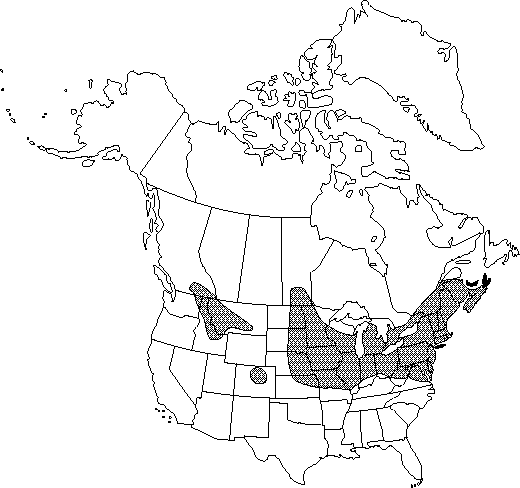Berberis vulgaris
Sp. Pl. 1: 330. 1753.
Shrubs, deciduous, 1-3 m. Stems dimorphic, with elongate primary and short axillary shoots. Bark of 2d-year stems gray, glabrous. Bud scales 2-3 mm, deciduous. Spines present, simple or 3-fid. Leaves simple; petioles 0.2-0.8 cm. Leaf blade obovate to oblanceolate or almost elliptic, 1-veined from base, 2-6(-8) × 0.9-2.8 cm, thin and flexible, base short- to long-attenuate, margins plane, finely serrate, each with (8-)16-30 teeth 0-1 mm high tipped with spines or bristles to 0.6-1.4 × 0.1 mm, apex rounded or obtuse; surfaces abaxially dull, smooth, adaxially dull, ± glaucous. Inflorescences racemose, lax, 10-20-flowered, 2-6 cm; bracteoles membranous, apex acute. Flowers: anther filaments without distal pair of recurved lateral teeth. Berries red or purple, ellipsoid, 10-11 mm, juicy, solid.
Phenology: Flowering spring (May–Jun).
Habitat: Roadsides, woods, old fields
Elevation: 0-1800 m
Distribution

B.C., Man., N.B., N.S., Ont., P.E.I., Que., Colo., Conn., Del., Idaho, Ill., Ind., Iowa, Kans., Maine, Md., Mass., Mich., Minn., Mo., Mont., Nebr., N.H., N.J., N.Y., N.Dak., Ohio, Pa., R.I., S.Dak., Vt., Va., Wash., W.Va., Wis., native, Europe.
Discussion
During the eighteenth and nineteenth centuries, Berberis vulgaris was very commonly cultivated in North America for thorn hedges and as a source of jam and yellow dye. It frequently escaped from cultivation and became naturalized over a wide area of eastern North America. It is susceptible to infection by Puccinia graminis. As the most important alternate host of this fungus, it has been the subject of vigorous eradication programs, and it is now infrequent or absent in many areas where it was once frequent (A. P. Roelfs 1982).
Selected References
None.